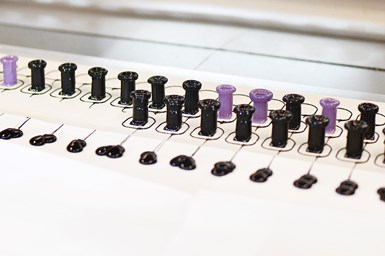Chromatic’s Smooth-Mode Technology for 3D Printing Durable Rubber Parts
The new technology is well suited for manufacturing rubber bladders and other elastomeric products that expand and contract.
Chromatic 3D Materials says it has developed a breakthrough Smooth-Mode technology for 3D printing durable rubber parts with ultrasmooth surfaces at commercial volumes. Now, industrial manufacturers can 3D print smooth, high-quality polyurethane parts — such as seals, gaskets, grommets, bladders and other elastomeric products — without the need for postprocessing or surface finishing, the company says.
It is said sealing requires a smooth surface, but 3D printed parts have always had layer lines or roughness. The company says it has developed a way to easily and cost-effectively 3D print products that are ultrasmooth without additional steps. The company says it’s a breakthrough for 3D printing those professional applications that must be airtight and watertight.
Parts printed with Smooth-Mode technology are said to have superior aesthetics as well as finer dimensional accuracy. For example, products can be printed with precise uniform thickness at submillimeter scale. Thus, the new technology is suitable for the production of rubber bladders and other elastomeric products that expand and contract.
Chromatic’s team of additive manufacturing experts first achieved ultrasmooth prints by fine-tuning the viscosity and surface tension of the company’s printable thermoset polyurethane materials. Then, they developed a way to go beyond simply applying the reaction technology to fused deposition modeling (FDM) printing. Smooth-Mode uses chemistry to create an ultrabonded and smooth part. The company says it believes this printing technique delivers the world’s smoothest printing along the Z or height axis.
Industrial manufacturers can take advantage of Smooth-Mode with Chromatic’s reactive extrusion additive manufacturing (RX-AM) materials and technology platform. A 3-in-1 platform, RX-AM includes materials, software and hardware for deposition printing with reactive chemistry. It uses printable polyurethanes with Shore A hardness ranging from 50 to 90 as well as custom grades with varying colors, hardnesses and special properties (for example, antibacterial, static discharge, biocides and more). The platform is designed for printing commercial volumes.
Related Content
-
3D Printed Titanium Replaces Aluminum for Unmanned Aircraft Wing Splice: The Cool Parts Show #72
Rapid Plasma Deposition produces the near-net-shape preform for a newly designed wing splice for remotely piloted aircraft from General Atomics. The Cool Parts Show visits Norsk Titanium, where this part is made.
-
This Drone Bird with 3D Printed Parts Mimics a Peregrine Falcon: The Cool Parts Show #66
The Drone Bird Company has developed aircraft that mimic birds of prey to scare off problem birds. The drones feature 3D printed fuselages made by Parts on Demand from ALM materials.
-
Beehive Industries Is Going Big on Small-Scale Engines Made Through Additive Manufacturing
Backed by decades of experience in both aviation and additive, the company is now laser-focused on a single goal: developing, proving and scaling production of engines providing 5,000 lbs of thrust or less.












